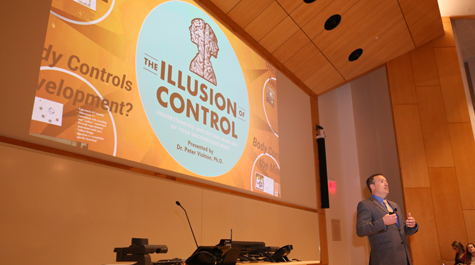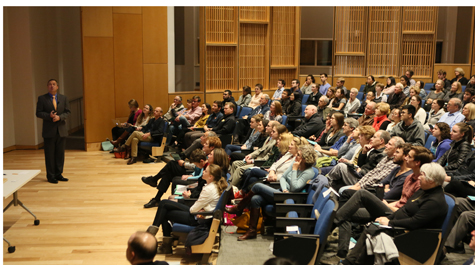Vishton challenges the illusion of control in 11th Tack Faculty Lecture
The 11th Tack Faculty Lecture started much the way many gatherings in an Integrated Science Center lecture hall do — with a test.
Peter Vishton, associate professor of psychology and lecturer for the event, recited a list of 15 words related to furniture and how you use it (table, desk, sofa, sitting, rocking) and asked the packed auditorium to recall as many words as possible several minutes later. To the surprise of the audience, many had remembered a word that wasn’t even said: chair.
“Our memory is inherently reconstructed,” explained Vishton. “You do recall little bits of information and particular kinds of incidents that happen, but then you tend to fill in the gaps. This happens fully unconsciously outside of our awareness.”
The exercise was the first of many examples Vishton used to explain the power of the unconscious in “The Illusion of Control: Understanding and Getting More out of your Unconscious Mind.” The event was part of the Tack Faculty Lecture Series, a program made possible by a generous commitment by Carl ’78 and Martha Tack ’78 in April 2012.
Delivered with enthusiasm and a healthy dose of humor, Vishton’s March 22 lecture, held in Theatre 1221 of the ISC 3, presented results from a wealth of studies that show unconscious drivers in our brains are the catalysts for decisions ranging from which way to walk to how much tip we should leave or how much we’ll eat in a restaurant.
Early studies by scientists Benjamin Libet and Alvaro Pascual-Leone, which analyzed brain activity during simple hand and arm movements, suggest your brain makes decisions before your conscious realizes it. Perhaps more disturbingly, Vishton said, Pascual Leone’s study shows that even when we are clearly not in control of our actions, we still maintain the illusion that we are.
“Every once in a while you do some behavior, at which point your conscious thought processes do two things,” said Vishton. “First, they take credit for it; they give you this powerful illusion that they were the ones that caused that action to happen. The second thing they do is make up a story about why you did what you did … Often that story isn’t especially or even at all related to the thing that actually caused the behavior to take place.”
Instead, Vishton said research shows that certain behaviors are hard-wired into our brains. When given a choice of similar or identical items in a row, for example, humans have a tendency to choose from the right side.
There are also roughly a dozen cognitive reflexes that explain our behaviors, from the “because” reflex that shows people are more likely to say yes to a request with a reason attached to it, to the “reciprocity” reflex, which is caused by an unconscious desire to return the favor after receiving a gift.
“Some of my favorite studies of this have been focused on the experience that we all have when we go to a restaurant,” said Vishton. “If you randomly select some guests to receive no mints [with their check] and randomly select others to receive mints, the people who receive mints give about 3 percent more in tips. If you give them two mints it jumps all the way up to 14 percent. These mints cost about one and a half cents, but they provide a fantastic return on investment.”
This unconscious driver, though helpful at times, can also sabotage conscious goals, such as those surrounding eating behaviors, Vishton said. Citing statistics from food-centric studies, Vishton revealed humorous and somewhat difficult to control unconscious behaviors (such as the tendency to order dessert around a waiter with a higher BMI) as well as practical tips for controlling diet by recognizing your unconscious impulses. Eating slowly, placing foods in opaque containers, and using smaller plates are all subtle changes that can trick your unconscious into eating less and still being satisfied.
“I like to suggest to people that they should think about changing not their own eating behaviors but someone else’s — in this case that someone is in your head with you,” said Vishton. “It’s almost like you’re trying to modify the behavior of an inner 2-year-old who loves sugar and fat and doesn’t care about fitness or health and just always wants to eat.”
Moving from figurative to literal babies, Vishton touched on his own research involving the role the unconscious plays in infant development. Vishton showed videos of a 4-month-old infant using his “Baby Kart” — a motorized chair that allows infants to independently drive around the room via simple movements of their head, arms and legs. Vishton hypothesized that infants’ brains are capable of tracking object locations using landmarks at this age, even though a range of studies have suggested that they do not develop this ability until around 7 months of age.
“Our prediction is that their brains have the ability to move in an allocentric fashion, it’s just that until they move independently, they don’t have any reason to do it,” he said.
Vishton closed the lecture by challenging the audience to think differently about their actions, their brains and the world around them.
“It’s not that there’s no reason to engage in good conscious thought,” Vishton said. “My hope is that when you make a decision, and when you find yourself performing some action, that you’ll at least hesitate in your complete confidence that you did it for the reasons you thought you did.”
















